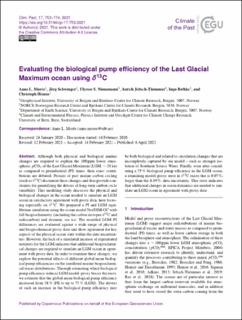| dc.contributor.author | Morée, Anne | |
| dc.contributor.author | Schwinger, Jörg | |
| dc.contributor.author | Ninnemann, Ulysses S | |
| dc.contributor.author | Jeltsch-Thommes, Aurich | |
| dc.contributor.author | Bethke, Ingo | |
| dc.contributor.author | Heinze, Christoph | |
| dc.date.accessioned | 2021-08-09T10:40:32Z | |
| dc.date.available | 2021-08-09T10:40:32Z | |
| dc.date.created | 2021-04-07T15:40:33Z | |
| dc.date.issued | 2021 | |
| dc.identifier.issn | 1814-9324 | |
| dc.identifier.uri | https://hdl.handle.net/11250/2766977 | |
| dc.description.abstract | Although both physical and biological marine changes are required to explain the 100 ppm lower atmospheric pCO2 of the Last Glacial Maximum (LGM, ∼21 ka) as compared to preindustrial (PI) times, their exact contributions are debated. Proxies of past marine carbon cycling (such as δ13C) document these changes and thus provide constraints for quantifying the drivers of long-term carbon cycle variability. This modeling study discusses the physical and biological changes in the ocean needed to simulate an LGM ocean in satisfactory agreement with proxy data, here focusing especially on δ13C. We prepared a PI and LGM equilibrium simulation using the ocean model NorESM-OC with full biogeochemistry (including the carbon isotopes δ13C and radiocarbon) and dynamic sea ice. The modeled LGM–PI differences are evaluated against a wide range of physical and biogeochemical proxy data and show agreement for key aspects of the physical ocean state within the data uncertainties. However, the lack of a simulated increase of regenerated nutrients for the LGM indicates that additional biogeochemical changes are required to simulate an LGM ocean in agreement with proxy data. In order to examine these changes, we explore the potential effects of different global mean biological pump efficiencies on the simulated marine biogeochemical tracer distributions. Through estimating which biological pump efficiency reduces LGM model–proxy biases the most, we estimate that the global mean biological pump efficiency increased from 38 % (PI) to up to 75 % (LGM). The drivers of such an increase in the biological pump efficiency may be both biological and related to circulation changes that are incompletely captured by our model – such as stronger isolation of Southern Source Water. Finally, even after considering a 75 % biological pump efficiency in the LGM ocean, a remaining model–proxy error in δ13C exists that is 0.07 ‰ larger than the 0.19 ‰ data uncertainty. This error indicates that additional changes in ocean dynamics are needed to simulate an LGM ocean in agreement with proxy data. | en_US |
| dc.language.iso | eng | en_US |
| dc.publisher | Copernicus Publications | en_US |
| dc.rights | Navngivelse 4.0 Internasjonal | * |
| dc.rights.uri | http://creativecommons.org/licenses/by/4.0/deed.no | * |
| dc.title | Evaluating the biological pump efficiency of the Last Glacial Maximum ocean using δ13C | en_US |
| dc.type | Journal article | en_US |
| dc.type | Peer reviewed | en_US |
| dc.description.version | publishedVersion | en_US |
| dc.rights.holder | Copyright Author(s) 2021. | en_US |
| cristin.ispublished | true | |
| cristin.fulltext | original | |
| cristin.qualitycode | 1 | |
| dc.identifier.doi | https://doi.org/10.5194/cp-17-753-2021 | |
| dc.identifier.cristin | 1902792 | |
| dc.source.journal | Climate of the Past | en_US |
| dc.source.pagenumber | 753-774 | en_US |
| dc.relation.project | Norges forskningsråd: 270061 | en_US |
| dc.relation.project | Notur/NorStore: NN2980K | en_US |
| dc.relation.project | Norges forskningsråd: 229771 | en_US |
| dc.relation.project | Notur/NorStore: NN2345K | en_US |
| dc.relation.project | EC/H2020/641816 | en_US |
| dc.relation.project | Notur/NorStore: NS2980K | en_US |
| dc.relation.project | Notur/NorStore: NS2345K | en_US |
| dc.identifier.citation | Climate of the Past. 2021, 17, 753-774. | en_US |
| dc.source.volume | 17 | en_US |

